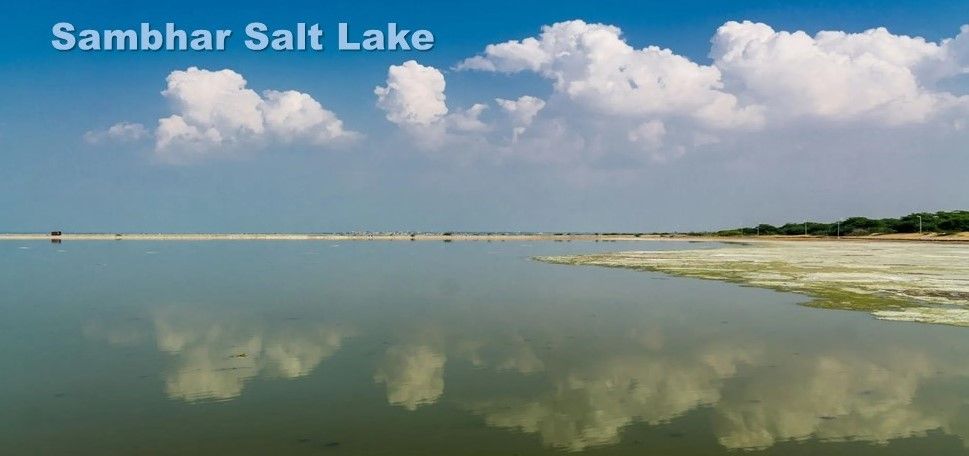
Sambhar Salt Lake, nestled in the heart of Rajasthan, is India’s largest inland Salt Lake and a fascinating blend of ecological richness, historical depth, and mythological lore. Spanning across the arid landscape, this shimmering expanse of saline water has been a vital source of salt production for centuries and continues to captivate visitors with its surreal beauty and cultural significance.
Location and Geography
Sambhar Salt Lake is located approximately 96 kilometers southwest of Jaipur and 64 kilometers northeast of Ajmer, along National Highway 8. It lies in the Sambhar Lake Town in Rajasthan, surrounded by over 30 villages that depend on the lake for their livelihood. The lake stretches over 22.5 kilometers in length and 3 to 11 kilometers in width, covering an area of around 230 square kilometers.
A 5-kilometer-long dam divides the lake on its eastern end, separating the salt evaporation ponds from the main water body. These ponds have been used for centuries to harvest salt, making Sambhar a cornerstone of Rajasthan’s salt industry. A narrow-gauge railway line runs along the eastern side of the dam, connecting Sambhar Lake City to the salt works and facilitating transportation.
Historical Background
The lake has a rich historical legacy. It was once jointly owned by the royal families of Jaipur and Jodhpur, who managed its salt production. During the British colonial era, the lake was leased to the British administration, which further developed its salt extraction infrastructure. After India’s independence, the Government of Rajasthan took over the lake and its operations, establishing Sambhar Salts Ltd., a public sector enterprise that manages salt production today.
Ecological Importance
Sambhar Salt Lake is a designated Ramsar site, recognized as a wetland of international importance. Its ecological significance stems from its role as a critical habitat for migratory birds, especially during the winter months. The lake attracts tens of thousands of flamingos, black-headed gulls, northern shovelers, and other avian species from northern Asia.
More than 45 species of aquatic birds including ducks, geese, and shorebirds have been recorded here, making it a paradise for birdwatchers and ornithologists. The lake’s fluctuating water levels, ranging from a few centimetres in the dry season to up to 3 meters after the monsoon, create diverse microhabitats that support a wide range of flora and fauna.
Human Settlements and Salt Production
The lake is encircled by numerous villages, including Sambhar, Gudha, Jabdinagar, Nawa, Jhak, Korsina, Jhapok, Kanseda, Kuni, Tyoda, Govindi, Nandha, and Sinodiya. These settlements are deeply intertwined with the lake’s salt economy. Traditional methods of salt extraction are still practiced, with workers manually collecting salt from evaporation ponds.
Sambhar Salt Lake contributes significantly to Rajasthan’s salt production, supplying both industrial and edible salt across the country. The salt pans, glistening under the sun, create a mesmerizing landscape that draws photographers and tourists alike.
Mythological Significance
The lake’s origins are steeped in mythology. According to the Mahabharata, Sambhar was part of the kingdom of the demon king Brishparva. His priest, Sukracharya, is believed to have resided here, and the marriage of his daughter Devayani to King Yayati is said to have taken place on the lake’s shores.
Another legend attributes the lake’s creation to Goddess Shakambari, the patron deity of the Chauhan Rajputs. It is believed that she initially transformed the region into a land of precious metals. However, when the people expressed dissatisfaction, she turned it into a salt-rich plain, giving rise to the Sambhar Salt Lake. This tale underscores the lake’s spiritual and cultural resonance among local communities.
Environmental Threats
Despite its ecological and economic importance, Sambhar Salt Lake faces several environmental challenges:
- Water Scarcity and Desertification: Reduced rainfall and over-extraction of groundwater have led to declining water levels, threatening the lake’s ecosystem.
- Grazing Pressure: Domestic animals from surrounding villages exert pressure on the lake’s vegetation, disrupting its natural balance.
- Illegal Hunting: Despite a ban on hunting, poaching of migratory birds continues to be a concern.
Moreover, there is a lack of comprehensive conservation measures. No detailed ecosystem study has been conducted to formulate a long-term management plan. Urgent intervention is needed to preserve the lake’s biodiversity and ensure sustainable salt production.
Connectivity and Tourism
Sambhar Salt Lake is well-connected by road and rail. The nearest airport is Jaipur International Airport, while the closest railway station is Sambhar Salt Lake Station. The lake’s accessibility makes it a popular destination for eco-tourism and cultural exploration.
Visitors are drawn to its ethereal landscapes, especially during sunrise and sunset when the lake reflects hues of pink and orange. The sight of flamingos wading through the shallow waters adds to its allure. The nearby Shakambari Devi Temple also attracts pilgrims and tourists interested in the region’s spiritual heritage.
Conclusion
Sambhar Salt Lake is more than just a salt-producing basin it is a living testament to India Natural Wealth, historical legacy, and mythological traditions. As a Ramsar site, it holds global ecological significance, while its cultural narratives enrich the tapestry of Indian folklore. However, to safeguard its future, proactive conservation efforts and sustainable management practices are essential.